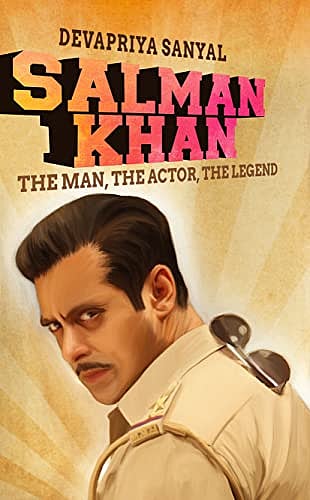The Spectator’s Star

In Bollywood, if there is one superstar who is yet to be fully or even partially understood by the industry, media, and fans alike, it has got to be Salman Khan. In fact, he has often been misunderstood and remains an enigma for many. Despite such incomprehensibility, Salman Bhai (as he is lovingly called) rules the popularity charts and is arguably one of the biggest stars in the country. Any reasonable attempt to decode this phenomenon seems like an exercise in futility. And that is why Devapriya Sanyal, in her book on the megastar, Salman Khan: The Man, The Actor, The Legend, aptly titles her first chapter, ‘Dil Mein Aata Hu, Samajh Mein Nahin’ (Khan’s dialogue from Kick).
In a business where many actors disappear after just one film, Salman Khan has been ruling the hearts of his admirers for more than 30 years despite being controversy’s favourite child. Sanyal, however, writes that Khan’s off-screen bad-boy image contributes to his superstardom. The court cases, alleged mistreatment of female co-stars, and altercation with the media have only helped build an aura of mystery around Khan, making him a captivating figure for the audience. One of the primary reasons for his longevity and unparalleled success is the frequent reinvention of his on-screen persona.
The book traces Khan’s oeuvre right from his modelling days as a lean-but-confident teenager, followed by his superhit romantic films in the ’90s, to his revamped avatar of a hyper-masculine action hero in the noughties. Sanyal discusses and analyses Khan’s influential movies and roles in great detail, the ups and downs in his career, and his change of fortune since Wanted in 2009. From becoming a superstar through his most-loved character of Prem; the ideal son, brother, lover, and family man in countless films, to portraying the macho hero but with a sensitive heart in some of the biggest blockbusters of Bollywood, Salman Khan has come a long way.
2025 In Review
12 Dec 2025 - Vol 04 | Issue 51
Words and scenes in retrospect
But these are details known to most people who are aware of the actor’s film trajectory. What Sanyal attempts to do in her book is to academically deconstruct Khan’s star persona in the context of celebrity studies by referencing film theorists and sociologists, including Richard Dyer and Peter Burke. She relies on the theoretical framework, Emploi, developed by sociologist Erving Goffman, to demystify Khan’s magical on-screen aura. Emploi accounts for the close interaction between the actor’s performance and the spectator’s reception, resulting from the latter’s involvement in the spectacle. This holds true in the case of a Salman Khan or a Rajinikanth starrer, where the actors’ performances do not matter as such; it is only the audience that matters.
The book highlights Khan’s debut solo feature, Maine Pyar Kiya (1989), which instantly catapulted him to stardom. Sanyal gives context to this breakthrough film by tracing the journey of heroes and films in Hindi cinema since the Nehruvian era. The ’70s were marked by the reign of Amitabh Bachchan, whose ‘Angry Young Man’ character resonated with the audience who were frustrated with the country’s socio-political climate. This trend spilled over to the ’80s, and heroes like Anil Kapoor and Sunny Deol continued the vigilante fight against the corrupt system. But this changed when Aamir Khan and Salman Khan ushered in a revolution in Bollywood with Qayamat Se Qayamat Tak (1988) and Maine Pyar Kiya, respectively, as their movies not only redefined the notion of romance but also pioneered a transition in the storyline and treatment of mainstream Hindi films.
Beyond the professional analysis of Salman Khan through his films, television shows, brand endorsements, and charitable acts, Sanyal tries to give the reader a glimpse into the man behind the legend. Khan’s close friend and initial mentor, Kailash Surendranath, is frequently mentioned in the book. Through his shared anecdotes and opinions, Sanyal tries to solve the jigsaw puzzle, that is Khan. Surendranath fondly recollects giving Khan his first break in modelling and subsequently standing by his protege through thick and thin. Despite becoming a massive star, Khan continues to randomly drop by at his home in the middle of the night for parathas and bhurji. Surendranath gives Khan a clean chit regarding his much-hyped failed romantic relationships with Sangeeta Bijlani and Aishwarya Rai and projects his friend as a loyal and respectful partner. But then Khan has landed in trouble many a time for his “rough” behaviour, and Salim Khan has always had to apologise for his son’s mistakes.
Perhaps, this duality in Salman Khan’s personality makes bhaijaan an incomprehensible celebrity whose magical charm cuts through demographics and social strata. For no intellectual argument can justify an English Literature graduate who has done her PhD in the cinema of Satyajit Ray, writing a 200-plus page book on Bollywood’s superstar enigma.

